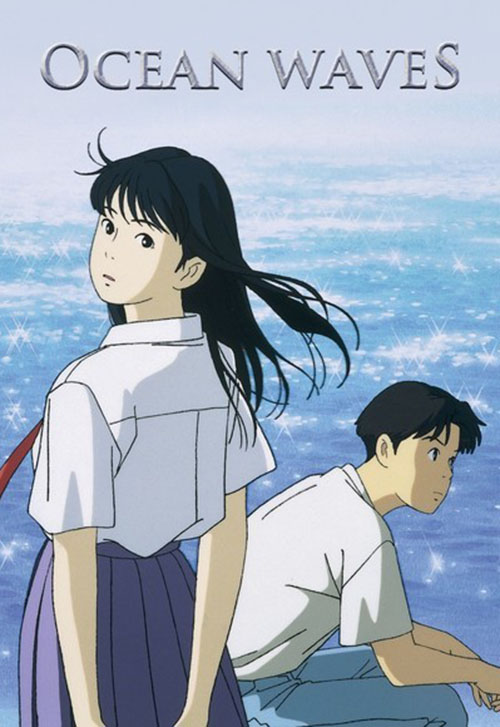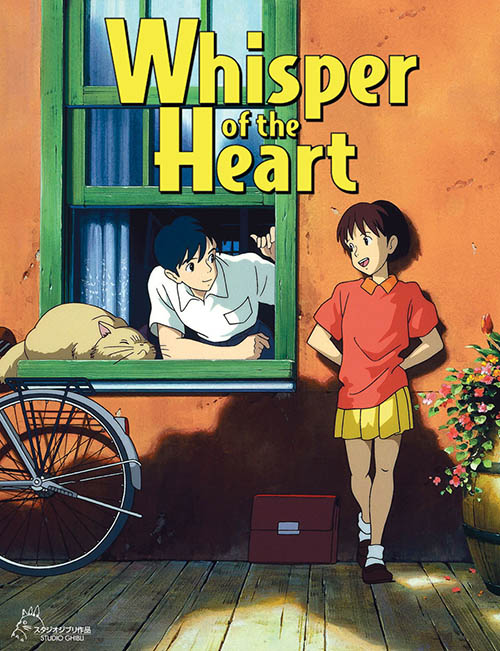I want to start the year in a romantic mood, to inspire you to higher levels of creativity and originality, and we can’t get there by rewatching the latest big star-driven, derivative superhero spectacle or sequel.
Instead, feast on creative movies that haven’t gone through parody and cultural decline. Feast on tales unencumbered by formula and Hollywood committee:
Romantic Anime! (No prior fandom required.)
The following were selected for their varied approach to romance, involving young protagonists on that “cusp of an era,” moment of great change in their lives.
The films are also not long. Anime TV can be too much of a commitment, and if you learn nothing else on this list, it’s that time isn’t something you can waste.
The Girl Who Leapt Through Time
We begin with this gem because of its clever take on the time travel trope.
Unlike other time-twisting tales (Back to the Future, Terminator, whatever the X-Men are up to), this one keeps the jumping small, and allows our protagonist the Groundhog Day-like ability to make repeated, subtle changes to her life.
Makoto is a likeable but unfocused senior in high school who pals around with two popular guys, Chiaki and Kosuke. While other girls wonder if she’s dating either or both of them, she enjoys playing baseball (catch, to be specific).
But as the note on the chalkboard says, “Time waits for no one.” Summer is coming, and the three will soon be separated.
Then Makoto falls on – let’s call it an acorn – which imprints something in her arm. Then on the way home from school, her bike fails to break at the railroad crossing, and she’s killed.

Instead of dying, she leaps back to the beginning of the previous day. After several comic attempts, she learns to stuff 11 hours of karaoke into one hour, get to time for class, ace that quiz she [recently?] failed, and so forth.
But as she changes her world, other people suffer. Makoto finds herself correcting gaffs while trying to dodge Chiaki asking her out, and setting up Kosuke with a junior who has a crush on him.
Then she realizes that she has a finite number of leaps, and she’s running out.
The story is full of clever plotting, and an alternate take on the familiar time-travel conceit. What sells it is Makoto, her expressiveness, weaknesses, and her will to do the right thing.
The theme involves making the most of opportunities because as everyone on the cusp of an era knows, time waits for no one.
Howl’s Moving Castle
If you love Pixar and always wanted to know where they get their inspiration, the short answer is: Hayao Miyazaki. Studio Ghibli is known for a number of gems, and Howl’s Moving Castle is among the best, bringing not only amazing animation, but romance (duh), and magic.
It’s the story of a young woman, Sophie, who is turned into an old woman by a witch and her only hope is Howl, a daring wizard on the run.

Viewers immediately notice the intricate animation of the ornate walls and architecture, the tile on Howl’s sideboard, and the funny flying machines.
Billy Crystal’s delivery of the fire demon is an ingenious device that turns the story, along with, of course, the color dial over the door that serves as a portal for Howl and others.
These ideas themselves could decorate any number of magic movies, but then the writers layer them for impact: Howl gives Sophie a guide ring to draw her back to Calcifer, which she uses to go through the portal into Howl’s past.
Then as she reaches young Howl swallowing young Calcifer, the ring breaks, dropping Sophie back through time as she calls out: “I know how to help you now. Find me in the future!”
The top of the story’s emotional theme involves Sophie growing younger as she stands up for Howl to his nemesis, Madame Suliman.
There are also some plot issues, like what reason would the Witch of the Waste have for turning Sophie into an old woman in the first place?
What’s up with Howl’s girly tantrum: “I’m nothing if I can’t be beautiful”?
The two worst moments are the “hearts can change” comment tacked onto the end, along with Suliman canceling the war because Howl found his true love.
This last point brings up the perennial struggle for writers: how to resolve multiple storylines for the best impact. For Howl, how would we resolve the triple conflict of releasing the prince from his curse, ending the war, and restoring Howl’s heart?
I think a better ending would involve Sophie restoring Howl’s heart first, making him powerful enough to defeat Suliman (heroic ending), and in that grand scene, Sophie breaks the prince’s curse. Then Howl and Sophie rush into each other’s arms without the Witch of the Waste flirting with the lost prince (yack!).
That’s just me. If forced into another story session I might have Sophie break the prince’s curse first, whereby he can tell Suliman to call off the war while Sophie “wins Howl’s heart” for a final romantic punch.
We might carry that squabble through our Romantic Anime series. But we all agree that Howl’s Moving Castle is rapturous entertainment for the whole family, and awe-inspiring for storytellers.
When Marnie Was There
A lesser-known, potentially depressing but ultimately uplifting “ghost” story is When Marnie Was There.
It’s the story of Anna, an emotionally repressed, sullen teen (sound like anyone you know?) who is sent to the countryside for the summer.

She lives with her aunt and gets bounced to an easy-going relative in a seaside town. Anna spends her summer drawing in her sketch pad, and for reasons she doesn’t know at first, she’s drawn to an abandoned mansion on the water.
She insults some other teen, cutting off her social life, and then runs into Marnie – a pretty blond who lives at the mansion! When Anna’s with Marnie, the house is renewed. There is a party, with rich guests and servants.
Anna and Marnie bond immediately, and steal hours on the water, in the woods, and even dare to enter the abandoned tower that is assumed to be haunted. But Anna doesn’t know if Marnie is a figment of her imagination, or a ghost, or something else.
My FAN gathering at Epiphany Space in Hollywood found the tale powerful and cathartic, a gothic romance, if we can call it that.
The story also has a way of burrowing into our memories of the past, those close buddy relationships from childhood.
SPOILER WARNING
The FANs had a great discussion about the writer’s balance of Marnie, whether her character is an unfulfilled ghost that needed Anna’s forgiveness, or if she’s Anna’s memory of her grandmother she felt abandoned her.
Either way, the story’s ultimate revelations are emotionally satisfying.
We agreed that the first act moved rather slowly, as Marnie doesn’t show up until 30 minutes in.
There’s also an exposition problem. Much of the backstory was conveyed by a minor character late in the film. This was probably done for the emotional effect since giving away anything before would have given too much (ahem, spoiler) and mitigated its impact.
For writers, it’s better to have the protagonist uncover exposition and backstory like an investigator rather than hear the details all at one like a spectator.
For example, Vanilla Sky (AKA Open Your Eyes) unfolds with many twists without conveying enough backstory, so it halts the narrative in order to give you the real story.
You never want to halt the narrative to explain things. (See also Shelter Island).
Then there’s the elephant in the tale: the proto-lesbian obsession Anna has for Marnie. (Um, it’s the reason why this lands on a romantic anime list)
Yeah yeah, some will argue that’s a step too far, that we’ve all had close same-sex friends, before and after puberty, people we cared for deeply, and who seemed to hold the world together for us.
But there’s also Anna’s jealousy when Marnie danced with her male cousin. Some unhealthy obsession that left Anna confused.
Again, the writers didn’t apply labels. I am. It’s as romantic as any child’s friend-obsession is, and it’s that tenuous thread that allowed the writers to craft a creative work of intergenerational love that heals the troubled soul.
Ocean Waves
Another leap back into high school romance and nostalgia, Ocean Waves tells the story of Taku, a decent, hard-working guy whose social life is turned upside down by a hot transfer student from Tokyo, Rikako.

At first he thinks his buddy Yutaka was going to date her, so he puts her out of mind. But Rikako hits up Taku for money on a class trip because she said she lost her money. Then Taku discovers she using the money to buy two plane tickets to Tokyo and Taku finds himself as her chaperone!
Rikako’s parents divorced, and her surprise trip reveals that her father is living with someone else. She passes off Taku as her boyfriend, but Taku keeps getting a raw deal.
Even worse, Rikako tells their classmates that they spent the weekend in a Tokyo hotel (leaving out the fact that Taku slept in the bathtub).
A few slaps later, and they’re not speaking. It’s only the weekend of their class reunion, a year later, after finally running into her on a train platform, that Taku can admit that he was always crazy for her.
It’s a slice of life tale, with a teen “femme fatale” making waves.
While the incidents are not earth-shattering, the story is well told, and the characters feel real.
But the real question for discussion is: is she really the one that got away or the bullet he dodged?
A case can be made for either. At a class reunion, our recollections soften, simply because we’ve moved past the emotions and the tension of the moment. We’re no longer bound by the school culture. We’ve matured.
So Taku may be correct in believing that the old rumors are not as important as his relationship to her. And perhaps others can confirm what perhaps he didn’t realize at the time: that he has unresolved feelings for her.
On the other hand, he was probably right to let the hot, troubled girl slip away. Had he continued, he might have swallowed a heap more suffering for his troubles and ended up no better.
Plus, the movie doesn’t indicate that they will hit it off again in Tokyo, or that she’s overcome the emotional damage her parents’ divorce caused. It’s an interesting topic for discussion.
For writers, Ocean Waves provides an entry into our own backstories, and all those relationship “what ifs” left unresolved.
Whisper of the Heart
This one is more of a “learning experience” than a “Must see.”
Miyasaki wrote and Yoshifumi Kondō directed Studio Ghibli’s Whisper of the Heart (1995), a story about a bookish girl, Shizuku, who connects with the boy who previously checked out all of the library books she chooses.
Actually, she starts by Shizuku wondering who the Seiji guy is while despising the “jerk” that teased her, calling her song lyrics corny (yup, it’s the same guy).

Shizuku tries to set up her best friend Yuko with a baseball-playing guy, Sugimura, and then Shizuku follows a random cat from the subway into a shop owned by (you guessed it) Seiji’s family, where the antiquities, especially a cat baron statue, ignites her creative writing impulse.
Starting with such coincidences, Miyasaki’s story wanders, not quite able to stick to the love story’s “pride and Prejudice” dynamic. Shizuku accidentally (ie. NOT on purpose) leaves behind items for Seiji to return.
The two finally connect over Seiji’s violin making (and her new lyrics for John Denver’s “Country Roads”), and then Seiji leaves to test for violin school and Shizuku falls into “proving herself worthy of Seiji” by writing the Baron cat story.
After swallowing the conceit of library cards listing the names of people who check it out, and that Japanese girls are obsessed with “Country Roads,” you might feel that the young love story was charming but unfocused.
The charming involves one aspect of young love: while Shizuku tries to set up her best friend Yuko with Sugimura, whose “too dense to notice,” Sugimura confesses that he’s always had a crush on Shizuku for years, which she failed to notice. That was perhaps the best moment in the film.
This concept of clueless youth is then brought home when Shizuku discovers that Seiji had stalked her in the library for months and took out those books in the hope that she would notice.
Then the corny, on-the-nose love confessions ruin what good will the story built up. Try to be more subtle, writers.
The theme is good for kids. We not only have to dig deep to find the gems (talents/dreams/ goals) within ourselves, we also have to polish them with many years of hard work.
TRIVIA: The studio seemed so enamoured by Shizuku’s Baron cat story subplot that it through our puppy-love story off balance. Seven years later, in 2002, the baron gets his own fantasy tale, The Cat Returns.
Your Name
This is the one that made me start the list. The final installment in the romantic anime series, Your Name, became a cultural phenomenon in 2017, becoming the 4th largest grossing movie in Japan’s history.
The story involves Mitsuha and Taki, the country girl and city boy, who wake up in each other’s bodies several times over the course of a few weeks as a comet streaks across the sky.

But there’s more: their connection is related to a red cord, intricately woven, representing emotions and relationships intertwined, connecting and reconnecting, and the power of a god connected with the Saki that Mitsuha’s family has been making for generations.
But basically, it’s an off-and-on again gender switch story that allows the two to interfere with each other’s awkward teen lives.
Taki is an overworked student/waiter with a crush on a beautiful coworker. Mitsuha is the town mayor’s daughter, bored, living with her grandmother and burdened with the traditional saki-making process (which involves her chewing rice and drooling it back into a container and then burying it in a cave near where a comet crashed 1200 years ago).
The two use their cell phones to trade notes on their switch days. Taki in Mitsuha’s body carries grandma to the saki-site, while Mitsuha as Taki asks out the hot girl on a date that Taki will have to deal with when he wakes as himself.
Director Makoto Shinkai makes the switch scenes and montages hilarious and engaging, until the switching abruptly stops.
Then Taki sets off to meet Mitsuha, and discovers that the comet destroyed the village 3 years ago. Everyone he met as Mitsuha is dead.
So he finds and drinks the buried saki, falls into a dream that sends him back to that fateful event again, in time to warn the village and tell Mitsuha that he loves her.
Several scenes convey their inter-connectedness perfectly. You will love Mitsuha’s casting Taki her red cord on the train, as well as their meeting at the crater site, as their 3-year time separation collapses in the magic hour.
Like John Woo’s Face/Off, the switched characters seem more effective in each other’s lives because of their outside perspective. That is, Mitsuha can ask out the hot girl because unlike Taki, she hasn’t gone through the longing and rejection that guys cope with.
Alternatively, her feminine side is more appealing to another girl. (Talk amongst yourselves!)
However, there are a growing number of complications. We have body switch with a surprise time shift, magic saki with time cords, and then memories and messages disappearing. It sort of works together but for writers, it’s dangerous to mix two or more separate odd elements in a story.
That said, what makes Your Name resonate is that odd element of forgetfulness. We all have that sense of “Have we met before?” that inexplicably draws us to certain people. Never before have we thought that, yes, we have, and saved their world while we were asleep!
Finally, did you notice how many movies in the series deal with time leaping. Perhaps this is a Japanese thing. Or perhaps it’s a desire of youth. As teens we all struggle with our growing independence, leaping toward adulthood while mourning our passing childhood, and realizing that our teen years and the time with school friends won’t last.
That’s one of the recurring themes that made our romantic anime series emotionally challenging and satisfying.
